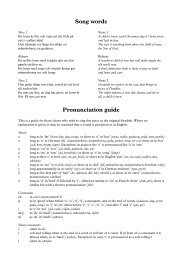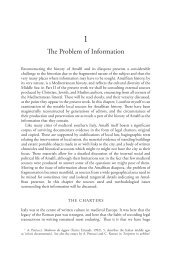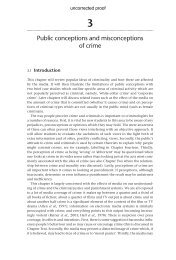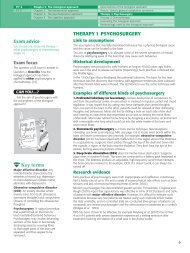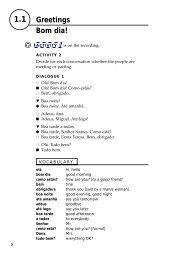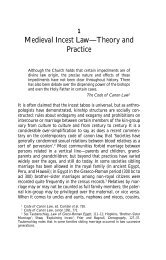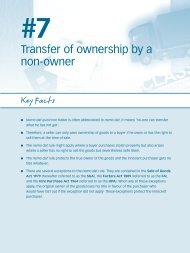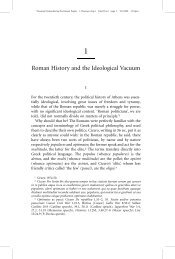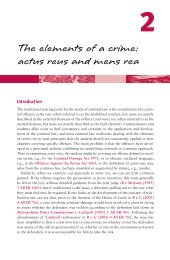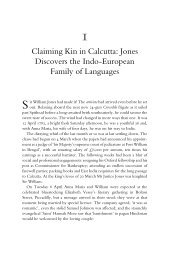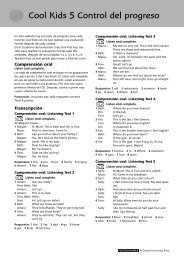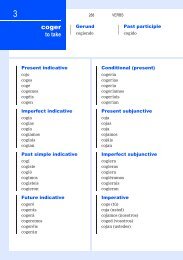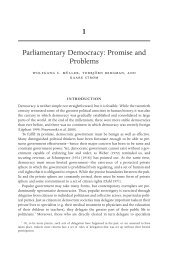4. Iseult Gonne, c 1918, courtesy Christina Bridgewater.
4. Iseult Gonne, c 1918, courtesy Christina Bridgewater.
4. Iseult Gonne, c 1918, courtesy Christina Bridgewater.
You also want an ePaper? Increase the reach of your titles
YUMPU automatically turns print PDFs into web optimized ePapers that Google loves.
<strong>4.</strong> <strong>Iseult</strong> <strong>Gonne</strong>, c <strong>1918</strong>, <strong>courtesy</strong> <strong>Christina</strong> <strong>Bridgewater</strong>.
4<br />
The Living Beauty: <strong>Iseult</strong> <strong>Gonne</strong><br />
In August 1912, while staying with Maud <strong>Gonne</strong> and her daughter <strong>Iseult</strong><br />
at their summer home near Colleville in Normandy, Yeats wrote three<br />
poems that reflect a fundamental shift in his relationship to his Muse. The<br />
process set in motion that month culminated in October 1917, when<br />
Yeats abandoned the courtly love tradition and embarked on an entirely<br />
different pathway to the Muse. The last two years of this period witnessed<br />
so profound a transition in Yeats’s creative process that Harold Bloom,<br />
writing in 1970, urged that ‘Future and still better-informed criticism of<br />
Yeats than we have should focus itself on the two years from late 1915 to<br />
late 1917, for these were the most important in Yeats’s imaginative life.’ 1<br />
<strong>Iseult</strong> <strong>Gonne</strong> stands at the center of this ferment.<br />
In the first of the August 1912 poems, ‘Fallen Majesty’ (VP 314),<br />
Yeats consigns Maud <strong>Gonne</strong> to the past:<br />
Although crowds gathered once if she but showed her face,<br />
And even old men’s eyes grew dim, this hand alone,<br />
Like some last courtier at a gypsy camping-place<br />
Babbling of fallen majesty, records what’s gone.<br />
The poet is no longer a vigorous practitioner of the ‘old high way of<br />
love,’ but is reduced ‘to some last courtier’ whose song has turned to<br />
babbling. Rather than building a new Irish consciousness, he merely<br />
records what’s gone.<br />
The second poem, ‘A Memory of Youth’ (VP 313), is a capsule<br />
summary of Maud <strong>Gonne</strong>’s career as both a wisdom-conferring priestess<br />
of the White Goddess and the beloved of the courtly love tradition. The<br />
first stanza emphasizes the importance Yeats attached to love as a source of<br />
wisdom. He had enjoyed ‘the wisdom love brings forth,’ but the moon,<br />
the source of a Muse’s wisdom, was obscured by a cloud:<br />
The moments passed as at a play;<br />
I had the wisdom love brings forth;
104 W.B. Yeats and the Muses<br />
I had my share of mother-wit,<br />
And yet for all that I could say,<br />
And though I had her praise for it,<br />
A cloud blown down from the cut-throat North<br />
Suddenly hid Love’s moon away.<br />
The second stanza chronicles Yeats’s efforts as Muse poet – ‘I praised her<br />
body and her mind’ – and the last stanza asserts that Love would have<br />
died, were it not that a ‘little bird’ tore the clouds from the moon, the<br />
source of inspiration:<br />
Believing every word I said,<br />
I praised her body and her mind<br />
Till pride had made her eyes grow bright,<br />
And pleasure made her checks grow red,<br />
And vanity her footfall light,<br />
Yet we, for all that praise, could find<br />
Nothing but darkness overhead.<br />
We sat as silent as a stone,<br />
We knew, though she’d not said a word,<br />
That even the best of love must die,<br />
And had been savagely undone<br />
Were it not that Love upon the cry<br />
Of a most ridiculous little bird<br />
Tore from the clouds his marvellous moon. (Id.)<br />
The little bird who opened the door to the wisdom of the marvelous moon<br />
suggests the arrival in Yeats’s imagination of <strong>Iseult</strong> <strong>Gonne</strong>, the child who<br />
was conceived at the grave of her brother following her mother’s conversations<br />
with Yeats and George Russell about the possibility of reincarnating<br />
the deceased child. (Life 1, 115–17) She is the subject of the third August<br />
1912 poem, ‘To a Child Dancing in the Wind’:<br />
Dance there upon the shore;<br />
What need have you to care<br />
For wind or water’s roar?<br />
And tumble out your hair<br />
That the salt drops have wet;<br />
Being young you have not known<br />
The fool’s triumph, nor yet<br />
Love lost as soon as won,<br />
Nor the best labourer dead<br />
And all the sheaves to bind.<br />
What need have you to dread<br />
The monstrous crying of wind? (VP 312)
<strong>Iseult</strong> <strong>Gonne</strong> 105<br />
<strong>Iseult</strong> <strong>Gonne</strong>, who turned eighteen in the month this poem was written,<br />
was no longer a child, and was too old, by four years, to qualify as a<br />
nymphet as defined by Nabokov’s Humbert Humbert. As will be seen,<br />
however, she did partake of what Humbert called the ‘demoniac’ quality<br />
of nymphets, their ‘fey grace, the elusive, shifty, soul-shattering, insidious<br />
charm’ 2 upon which, according to Lionel Trilling, ‘the Greeks<br />
based their idea of the disease of nympholepsy’ and others their conceptions<br />
of White Goddesses. 3<br />
At eighteen, <strong>Iseult</strong> <strong>Gonne</strong> also shared a quality attributed to the<br />
nymphet by Jenefer Shute, who points out that, whereas in Western<br />
culture generally, ‘to be a woman is to be viewed,’ ‘[i]n the case of<br />
Nabokov’s nymphets, however, the girl-woman has not yet constituted<br />
herself as an object of visual consumption, and it is the male viewer who,<br />
like an artist or a magician, must create from this recalcitrant material<br />
a landscape of desire.’ 4 In Shute’s terms, ‘To a Child Dancing in the<br />
Wind’ could be said to describe the ‘initial unconsciousness’ of the<br />
body, which is ultimately constituted the ‘object of desire.’ (Id.)<br />
A quarter century after Yeats pictured <strong>Iseult</strong> dancing in the wind, the<br />
memory of the occasion that prompted the poem was still a powerful<br />
image of unconscious energy: ‘My imagination goes some years backward,’<br />
Yeats wrote in the 1937 edition of A Vision, ‘and I remember a<br />
beautiful young girl singing at the edge of the sea in Normandy words<br />
and music of her own composition. She thought herself alone, stood<br />
barefooted between sea and sand; sang with lifted head of the civilisations<br />
that there had come and gone, ending every verse with the cry:<br />
“O Lord, let something remain”.’ (AVB 219–20) <strong>Iseult</strong>’s emergence as<br />
Muse is apparent in Yeats’s assertion ‘that the Upanishads – somebody<br />
had already given her the Pyramids – were addressed to the girl.’ (Id.)<br />
The tension between Yeats’s semi-paternal relationship with <strong>Iseult</strong><br />
and her nascent role as Muse simmers beneath the surface of ‘To a Child<br />
Dancing in the Wind.’ In the absence of <strong>Iseult</strong>’s father, who was not<br />
married to <strong>Gonne</strong> and lived apart from her from the time of <strong>Iseult</strong>’s<br />
birth (Mem 133), and her stepfather, who had reportedly molested her,<br />
and been separated from her mother, by the time she was fourteen (Life 1,<br />
330–1), Yeats, her mother’s long-time suitor, assumed a paternal role.<br />
<strong>Iseult</strong>’s need for a familial anchor was exacerbated by the fact that her<br />
mother – whom she called Amour (or Moura outside the family) – called<br />
her ‘a charming girl I had adopted’ or ‘an adopted niece’ or a ‘cousin.’ 5<br />
Yeats’s paternal role was so strong that <strong>Gonne</strong> would eventually maintain<br />
that Yeats was <strong>Iseult</strong>’s father, because, as Yeats put it in a letter to Gregory,
106 W.B. Yeats and the Muses<br />
‘she was full of my ideas’ when <strong>Iseult</strong> was born. 6 The situation was clear to<br />
<strong>Iseult</strong>. In January <strong>1918</strong>, after Yeats’s marriage, she inquired, in a postscript,<br />
‘Isn’t uncle nicer than father?’ 7<br />
From an early stage, the relationship between Yeats and <strong>Iseult</strong> <strong>Gonne</strong><br />
extended beyond the paternal. <strong>Iseult</strong>, who was raised in France and was,<br />
as Jeffares put it, ‘serieuse’ (IG 212), found an intellectual companion in<br />
Yeats. Even when she was ‘not quite fourteen,’ Yeats was writing to<br />
Gregory that <strong>Iseult</strong> had declared the Iliad her favorite book and that<br />
they agreed about plays, <strong>Iseult</strong> liking Julius Caesar and Goethe’s Iphigenia.<br />
There is a third thread in the relationship: Yeats notes that ‘[s]he is<br />
tall, very tall & slight, & will be very beautiful I think.’ 8 The Muse in<br />
<strong>Iseult</strong> had already begun to emerge. Ella Young recounts that, when<br />
<strong>Iseult</strong> was ‘a beautiful dark-eyed dark-haired girl of twelve or thirteen,’<br />
Yeats, while visiting Paris, came to the house daily, instructing <strong>Iseult</strong> in<br />
art, poetry, and literature, and ‘teaching her to chant verse as he thinks it<br />
should be chanted.’ 9 Thoughts of Florence Farr could not have been far<br />
away. As Young reports, Yeats was ‘desirous of chanting verse to the<br />
sound of a plangent string, a note now and then for accompaniment<br />
or emphasis.’ (Id.) There was more than a little rapport between pupil<br />
and teacher. During a visit in 1910, when she was not quite 16, <strong>Iseult</strong><br />
suggested that Yeats marry her. Yeats declined, citing too much Mars in<br />
her horoscope. 10 The seriousness and beauty of the young <strong>Iseult</strong> coalesce<br />
in a concise report of the occasion to Gregory that omits reference<br />
to the proposal, disclosing only that <strong>Iseult</strong> has ‘taken to St. John of the<br />
Cross’ and is ‘very tall & pretty. . . .’ 11<br />
Yeats began formal construction of <strong>Iseult</strong> as object of desire in the<br />
poem ‘Two Years Later’ (VP 312), probably written in December<br />
1913. In the interim since ‘To a Child Dancing in the Wind,’ <strong>Iseult</strong><br />
had spent June through August 1913 in London with her aunt<br />
Kathleen, during which time Yeats introduced her to Rabindranath<br />
Tagore, and wrote to Tagore describing her as ‘the start of a strong<br />
personality & of a very beautiful woman. . . .’ 12 <strong>Iseult</strong> had begun<br />
learning Bengali, taking lessons from Tagore’s nephew, Divabrata<br />
Muckerjee (IG 227–8), and in September 1914, Yeats asked Tagore<br />
to consider giving <strong>Iseult</strong> and Muckerjee the translation rights to<br />
certain of his poems, telling Tagore that he thought ‘very highly of<br />
<strong>Iseult</strong>’s literary gift so much so that . . . I offered to edit a little book of<br />
prose poems of hers in English and French.’ 13 ‘I know that the girl has<br />
a delicate feeling for words despite her youth,’ Yeats wrote, ‘& she has<br />
what may grow into very great literary talent.’ Yeats’s attraction to the
<strong>Iseult</strong> <strong>Gonne</strong> 107<br />
beautiful <strong>Iseult</strong> during her visit to London did not escape the notice of<br />
Ezra Pound, who wrote to Dorothy Shakespear that ‘the Eagle’ was<br />
‘burning tapers to some new scion or scioness of the house of <strong>Gonne</strong>.’<br />
(EP-DS Letters 338) ‘Two Years Later’ defines <strong>Iseult</strong> as an object of<br />
desire who stands so squarely in the shoes of her mother that she will<br />
‘suffer as your mother suffered’:<br />
Has no one said those daring<br />
Kind eyes should be more learn’d?<br />
Or warned you how despairing<br />
The moths are when they are burned?<br />
I could have warned you; but you are young,<br />
So we speak a different tongue.<br />
O you will take whatever’s offered<br />
And dream that all the world’s a friend,<br />
Suffer as your mother suffered,<br />
Be as broken in the end.<br />
But I am old and you are young,<br />
And I speak a barbarous tongue.<br />
‘On Woman (VP 345)’, written in May 1914 (WSC MM 135),<br />
provides a glimpse of Yeats’s state of mind as he began to construct<br />
<strong>Iseult</strong> into his Muse. A prose draft of the poem reflects the intensity of<br />
his longing for a woman in whom ‘our minds and our bodies [might]<br />
find rest.’ (Id. 429) He prays ‘O God, grant . . . for my gift . . . that I shall<br />
love some woman so that every passion, pity, cruel desire, the affection<br />
that is full of tears, the abasement as before an image in a savage tent,<br />
hatred even it may be, shall find its prey.’ (Id.) The poem itself first<br />
addresses the poet’s hope that his Muse, unlike Maud <strong>Gonne</strong>, will be<br />
someone with whom he can enjoy the supportive conversational rapport<br />
he was finding with <strong>Iseult</strong>:<br />
May God be praised for woman<br />
That gives up all her mind,<br />
A man may find in no man<br />
A friendship of her kind<br />
That covers all he has brought<br />
As with her flesh and bone,<br />
Nor quarrels with a thought<br />
Because it is not her own.
108 W.B. Yeats and the Muses<br />
Though pedantry denies,<br />
It’s plain the Bible means<br />
That Solomon grew wise<br />
While talking with his queens, . . .<br />
The second part of the poem yearns for the kind of sexual satisfaction<br />
Yeats never found more than fleetingly with Maud <strong>Gonne</strong>, the passion<br />
of Solomon and Sheba, the<br />
Harshness of their desire<br />
That made them stretch and yawn,<br />
Pleasure that comes with sleep,<br />
Shudder that made them one.<br />
Vendler, perhaps proleptically, suggests that ‘On Woman,’ which uses the<br />
Solomon and Sheba construct that Yeats would later apply to George<br />
Yeats after his marriage, was written to George Hyde-Lees. (Secret<br />
Discipline 188) Saddlemeyer takes the same view, explaining the fact<br />
that ‘On Woman’ predates Yeats’s marriage by more than three years by<br />
noting that Yeats was attending seances with George in the period when<br />
this poem was written. (BG 188) However, Jeffares, presumably based on<br />
conversations with Mrs. Yeats, says definitively that the poem ‘was not<br />
written to Mrs. Yeats.’ (NC 152) Perhaps Yeats, who wrote to Gregory in<br />
October 1917 that ‘I have always believed that the chief happiness &<br />
favour of my life has been the nobility of three or four woman friends,’ 14<br />
had more than one woman in mind. That <strong>Iseult</strong> was one of them seems<br />
apparent from the steady progress of Yeats’s relationship with her in terms<br />
of both aspects of the poem’s praise of woman.<br />
Yeats’s desire to fashion <strong>Iseult</strong> into her mother’s successor is explicit<br />
in ‘To a Young Girl’ (VP 336), written in May 1915. It opens with a<br />
salutation Yeats reserved for his most intimate addressees, and then finds<br />
in <strong>Iseult</strong> the same excitement he had celebrated in her mother in<br />
‘A Memory of Youth’:<br />
My dear, my dear, I know<br />
More than another<br />
What makes your heart beat so;<br />
Not even your own mother<br />
Can know it as I know,<br />
Who broke my heart for her<br />
When the wild thought,<br />
That she denies
<strong>Iseult</strong> <strong>Gonne</strong> 109<br />
And has forgot,<br />
Set all her blood astir<br />
And glittered in her eyes.<br />
The prospect of repeating his pursuit of the unattainable Maud <strong>Gonne</strong><br />
with her daughter was well calculated to arouse in Yeats the feeling that<br />
Freud describes as ‘the uncanny,’ an emotion stirred by a ‘factor of<br />
involuntary repetition which surrounds what would otherwise be innocent<br />
enough with an uncanny atmosphere, and forces upon us the idea<br />
of something fateful and inescapable. . . .’ 15 The profound unease in<br />
Yeats’s psyche as to the role being played by <strong>Iseult</strong> is reflected in<br />
‘Presences’ (VP 358), written in November 1915, at the beginning of<br />
the period Bloom characterizes as the most significant in Yeats’s imaginative<br />
life. (WSC MM 205) The poem tells a fascinating tale of an<br />
experience ‘so strange that it seemed/As if the hair stood up on my<br />
head.’ The triggering event was a dream in which three women who<br />
knew more than a little about his pursuit of the Muse – indeed, they had<br />
read all he had rhymed of ‘that monstrous thing/Returned and yet<br />
unrequited love’ – ‘[c]limbed up my creaking stair’ and hovered about<br />
the poet’s room ‘[i]n rustle of lace or silken stuff ’ until he heard their<br />
hearts beating. Yeats’s characterization of the core concept of courtly<br />
love – ‘Returned and yet unrequited love’ – as monstrous was carefully<br />
considered. He called it ‘curst’ or ‘cursed’ through several drafts, before<br />
settling on ‘monstrous.’ (WSC MM 204–9) The creaking stair that<br />
announces the arrival of the nocturnal Presences, forerunners of the<br />
Furies who will climb the stairs to Dorothy Wellesley’s bedroom in ‘To<br />
Dorothy Wellesley’ (VP 579), is reminiscent of the ‘heavy tread’ of the<br />
nighttime visitor heard by the child in E. T. A. Hoffmann’s story, ‘The<br />
Sand-Man,’ that Freud regarded as a classic example of the uncanny.<br />
(The Uncanny at 227) The three Presences are indistinguishable from<br />
one another until the last three lines of the poem. For example, the poet<br />
hears their hearts beating, but they all seem to beat alike, and there is no<br />
difference from one to another in their rustling lace or silken stuff. Even<br />
at the end of the poem, the differentiation amongst the three Presences<br />
is described in terms of generic categories of feminine presence, rather<br />
than qualities specific to a particular individual:<br />
One is a harlot, and one a child<br />
That never looked upon man with desire,<br />
And one, it may be, a queen.
110 W.B. Yeats and the Muses<br />
The generic nature of the Presences suggests that, like the Presences in<br />
‘Among School Children’ (VP 443), they are Platonic forms, albeit<br />
forms that bear biographical traces of Yeats’s Muses incarnate. The<br />
presence of ‘a queen’ in the trio of inspiring Presences is no surprise.<br />
Queen, lady, priestess, goddess are traditional guises of the Muse. The<br />
‘child’ reference bespeaks Yeats’s continuing effort to characterize <strong>Iseult</strong> as<br />
younger, and less of a sexual presence, than she was. The ‘harlot’ Presence<br />
is, at least initially, surprising, and perhaps it is surprise that has led to<br />
suggestions that the word refers to a particular individual, rather than a<br />
generic aspect of the Muse. Jeffares suggested that the word referred to<br />
MabelDickinson.(NC 159) Although the Dickinson pregnancy scare<br />
(see Chapter 3) still rankled, 16 there is no reason to single out Dickinson<br />
as the unique face behind the word ‘harlot’ in ‘Presences.’<br />
Another possible candidate for the role of harlot is Alick Schepeler,<br />
long-time mistress of Augustus John and the model for his La Seraphita.<br />
Yeats was sufficiently involved with Schepeler in the period leading up<br />
to the composition of ‘Presences’ that he wrote her in September 1915<br />
of a dream in which ‘I was paying devoted but anxious & rather distant<br />
attention to an entire stranger – my dread being that she might be on<br />
the edge of that infirmity we spoke of & my fear, which you attributed<br />
to the vanity of man.’ (CL InteLex 2763) Schepeler attended a number<br />
of Yeats’s Mondays in his rooms in Woburn Buildings in the period<br />
before and after the composition of ‘Presences,’ and, as Foster suggests,<br />
may be the ‘lady in the white bath-robe’ sitting in the ‘great chair/<br />
[b]etween the two indolent candles’ in Pound’s ‘Albâtre.’ (Life 2, 30)<br />
John’s biographer, Michael Holroyd, concludes that Schepeler’s ‘mind<br />
was a polished vacuum where the imagination of the artist was free to<br />
roam unimpeded,’ a quality that seemed to elicit visual art from John. 17<br />
She did not, however, provide the exchange of ideas that Yeats required<br />
in his Muses, and is not identifiable in his poetry. There is no reason to<br />
think that ‘Presences’ refers to her as a harlot.<br />
The term ‘harlot’ in ‘Presences’ is better understood as a generic<br />
quality of the Muse. This usage accords with the traditional belief,<br />
noted by Bloom without particular reference to Yeats, that ‘the Muse<br />
is mother and harlot at once’ because she presides at the birth of a poem<br />
but ‘has whored with many before.’ 18 Bloom suggests that the fusion of<br />
mother and harlot in the ‘wholeness of the poet’s imagination’ is an<br />
instance of Freud’s remark that ‘a pressing desire in the unconscious for<br />
some irreplaceable thing often resolves itself into an endless series in
<strong>Iseult</strong> <strong>Gonne</strong> 111<br />
actuality,’ a pattern, notes Bloom, ‘particularly prevalent in the love life<br />
of most poets. . . .’ (Id.)<br />
As noted in Chapter 1, the idea of the Muse as the eternal harlot<br />
Helen or Ennoia was familiar to Yeats from G. R. S. Mead’s book on<br />
Simon Magus, which contained the early Church Father Irenaeus’s<br />
account of how Simon identified a prostitute named Helena as ‘the<br />
first conception (or Thought) . . . , the Mother of All. . . .’ (Simon Magus<br />
8–9) This eternal feminine figure, according to Tertullianus, quoted in<br />
Simon Magus, ‘transmigrate[s] from body to body, in the extreme of<br />
dishonor . . . ticketed for hire.’ (Id. at 11) Moreover, Yeats knew from<br />
Flaubert’s The Temptation of Saint Antony that this Ennoia figure had<br />
many names, including Helen of Troy, but ‘really is the Moon.’ 19<br />
Warwick Gould and Deirdre Toomey, in their exhaustively annotated<br />
edition of Yeats’s Mythologies, point out that the idea of the eternal<br />
harlot, as recounted by Flaubert and Mead, lies behind Yeats’s story The<br />
Adoration of The Magi, in which the voice of a harlot is the source of the<br />
wisdom that would ‘so transform the world that another Leda would<br />
open her knees to the swan, another Achilles beleaguer Troy.’ 20 In his<br />
1909 diary, Yeats explored the idea of Simon Magus and Helena in a<br />
way that anticipates the notion he would later develop in an essay<br />
dedicated to <strong>Iseult</strong> that a poet finds his Muse in his anti-self. In his<br />
diary, he posits that there ‘is an astrological sense in which a man’s wife<br />
or sweetheart is always an Eve made from a rib of his body’ and that ‘a<br />
man may find the evil of his horoscope in a woman, and in rescuing her<br />
from her own self may conquer his own evil, as with Simon Magus who<br />
married a harlot.’ (Au 480–1)<br />
Yeats applied these ideas to the concept of the Muse in the preface to<br />
A Vision, saying that ‘Muses resemble women who creep out at night<br />
and give themselves to unknown sailors and return to talk of Chinese<br />
porcelain – . . . virginity renews itself like the moon. . . .’ (AVB 24) He<br />
put the notion of the Muse as harlot more simply in The Death of<br />
Cuchulain, where the tale he tells is one ‘the harlot/Sang to the beggarman.’<br />
(VPl 1063) In short, the notion of the Muse as harlot – unreliable<br />
and prone to shift her favor to a rival – was part of the fabric of Yeats’s<br />
thought. As he recognized the emergence of the Muse in a young<br />
woman who regarded him as something of a father figure, there must<br />
have been enormous pressure to separate her childhood from her<br />
Musedom. Thus, ‘Presences’ bifurcates <strong>Iseult</strong> into two categories: one a<br />
harlot, and one a child who never looked upon man with desire. The<br />
harlot attribution recognizes that <strong>Iseult</strong> is becoming a Muse, but the child
112 W.B. Yeats and the Muses<br />
attribution tries to deny it. The compartmentalization was so powerful<br />
that, years later, when Yeats enjoined poets to ‘Call the Muses Home’ in<br />
‘Those Images,’ the harlot and the child would still be two separate<br />
elements of the five that ‘make the Muses sing’:<br />
Seek those images<br />
That constitute the wild,<br />
The lion and the virgin,<br />
The harlot and the child.<br />
Find in middle air<br />
An eagle on the wing,<br />
Recognize the five<br />
That make the Muses sing. (VP 600)<br />
<strong>Iseult</strong> shares three of the attributes of the five that ‘make the Muses sing’:<br />
she is child, emerging harlot-like Muse and, so Yeats insists, virgin. Her<br />
mother, at one time or another, had manifested traits of all five and<br />
contemporaneously displayed aspects of four. As Muse, she is a harlot.<br />
In ‘Presences’ itself, Yeats remembers ‘What eagle look still shows’ in<br />
her once-virginal presence, and in ‘Against Unworthy Praise,’ she is<br />
‘[h]alf lion, half child’ (VP 260).<br />
Jeffares glossed ‘Those Images’ with the final passage of Yeats’s ‘An<br />
Introduction for My Plays,’ in which hetellsofanIndiantaleinwhich<br />
certain men asked ‘the greatest of sages’ to identify his ‘Masters,’ and he<br />
replied: ‘The wind and the harlot, the virgin and the child, the lion and the<br />
eagle.’ (E&I 530) ‘Presences’ eliminates the wind from the sage’s Masters,<br />
locates his ‘five that make the Muses sing’ in middle air, and limits itself to<br />
the five attributes manifested in the combination of Maud and <strong>Iseult</strong><br />
<strong>Gonne</strong>. The conjunction of harlot and child remained at the core of Yeats’s<br />
notion of the Muse. In ‘Long-legged Fly,’ written within a year of ‘Those<br />
Images,’ Helen, inspirer of both love and war, and linked with the harlot<br />
Helena by Simon Magus and Flaubert, is ‘part woman, three parts a child.’<br />
(VP 617) <strong>Iseult</strong>-like, she dances in her moment of creativity while, ‘Like a<br />
long-legged fly upon the stream/Her mind moves upon silence.’ (Id.)Thenotion<br />
behind ‘Presences’ of the conjunction of child and harlot in the Muse,<br />
although surprising at first glance, is a recurrent one in Yeats’s thought.<br />
Of course, the author of ‘Presences’ was well aware that the twentyone-year-old<br />
<strong>Iseult</strong> was no childish stranger to looking upon man with<br />
desire. ‘To a Young Girl,’ written just a few months earlier, implies<br />
precisely the opposite, and Yeats’s letter of the previous autumn to<br />
Tagore described <strong>Iseult</strong> as ‘the start of a beautiful woman.’ ‘Presences’
<strong>Iseult</strong> <strong>Gonne</strong> 113<br />
nonetheless insists on creating the category of an innocent child with<br />
whom Yeats could have a relationship consistent with the fact that, as he<br />
said in a letter to Gregory, ‘<strong>Iseult</strong> has always been something like a<br />
daughter to me. . . .’ 21<br />
While emerging as Muse, <strong>Iseult</strong> continued to pursue her serieuse<br />
intellectual interests and simultaneously tried to find her way in the<br />
world. By the spring of 1916, she had written, at least in her mother’s<br />
view, ‘some really remarkable things,’ including essays on d’Annunzio<br />
and Huysmans. 22 Yet she was no dilettante. She spent substantial time<br />
in 1914 and 1915 nursing wounded soldiers (IG 229) and took a job at<br />
an aviation association, a dull one, but, as she wryly observed, ‘still<br />
earning ones life is a new impression though rather a minor one.’ 23<br />
The year 1916 brought a deepening of Yeats’s relationship with<br />
<strong>Iseult</strong>. They saw a good deal of each other when she visited London<br />
in May. (IG 230) On 21 May, Yeats advised Maud <strong>Gonne</strong> that <strong>Iseult</strong><br />
was going to bring him to Colleville. ‘She is quite a commanding person<br />
now,’ he wrote, ‘no longer a fanciful child.’ 24 By 25 May, Yeats was<br />
reporting to Gregory that <strong>Iseult</strong> was ‘making a little stir’ and ‘would be a<br />
reigning beauty in no time’ if she lived in London. 25 The trip to<br />
Colleville was timely because John MacBride’s execution by the British<br />
for his role in the Easter 1916 uprising reopened the question of<br />
Yeats’s relationship to Maud <strong>Gonne</strong>. Yeats spent the summer of 1916<br />
at Colleville with both <strong>Gonne</strong>s, where, among other things, he began<br />
writing ‘Easter 1916,’ which celebrates MacBride even though ‘He had<br />
done most bitter wrong/To some who are near my heart.’ (VP 393)<br />
‘Easter 1916’ also articulates a thought about Maud <strong>Gonne</strong> that had<br />
previously been confined to prose, as, for example, in the passage from<br />
‘J.M. Synge and the Ireland of His Time’ that Yeats wrote at Colleville<br />
in the summer of 1910. Then, he spoke of ‘the morbid persistence of<br />
minds unsettled by some fixed idea . . . They no longer love, for only life<br />
is loved, and at last a generation is like an hysterical woman who will<br />
make unmeasured accusations and believe impossible things, because of<br />
some logical deduction from a solitary thought which has turned a<br />
portion of her mind to stone.’ (E&I 313–14) ‘Easter 1916’ put it<br />
more simply: ‘Too long a sacrifice/Can make a stone of the heart.’<br />
(VP 394) Although the poem is speaking generally of the 1916 rebels,<br />
<strong>Gonne</strong>, who shared their mindset, would not have missed the poem’s<br />
implicit criticism of herself. Her response was unsurprising. ‘No I don’t<br />
like your poem,’ she wrote upon reading the final version, ‘it isn’t
114 W.B. Yeats and the Muses<br />
worthy of you & above all it isn’t worthy of the subject. . . .’ 26 <strong>Gonne</strong><br />
insisted that ‘sacrifice has never yet turned a heart to stone. . . .’ (Id.)<br />
Yeats’s conduct shows that he had concluded that his own long<br />
sacrifice as courtly lover needed a definitive conclusion. As he reported<br />
matter of factly to Gregory from Colleville in the summer of 1916, he<br />
‘asked Maud to marry me, a few days ago. She said that it would be bad<br />
for her work & mine, & that she was too old for me.’ 27 Yeats seems not<br />
to have disputed either proposition. Instead, his letter moves quickly to<br />
<strong>Gonne</strong>’s daughter: ‘I am very much taken up with <strong>Iseult</strong>, not in the way<br />
of love or desire, but her joyous childhood absorbs my thought, & I<br />
hardly know what I feel.’ Tellingly, he concludes, ‘It makes Madame<br />
<strong>Gonne</strong> seem older than she is.’<br />
Yeats and <strong>Iseult</strong> spent many hours walking and swimming at Colleville<br />
in the summer of 1916. Yeats’s letter the following spring to the<br />
dying Florence Farr remarks, in a concluding comment, that his companion<br />
of the previous summer was ‘now a tall beauty, very mystical &<br />
subtle.’ 28 His letter to Gregory of 18 July 1916 shows him struggling to<br />
define <strong>Iseult</strong>. He has been looking over ‘a kind of diary’ she keeps in<br />
which she writes her prayer for ‘quiet and seclusion, the company of one<br />
or two dear friends, a wild and beautiful bit of earth to live in I ask for<br />
no more.’ 29 Her conversations with Yeats are serious. She has told him<br />
that she left the Catholic Church because, ‘loving nature as I do, loving<br />
each thing for itself & not for its creator,’ she found it impossible.<br />
Obviously, she is an adult. Yet, Yeats insists, ‘she is in many things a<br />
willful child,’ a comment explained, at least in part, by her insistence on<br />
smoking. Yeats goes on to report that she repented and handed over her<br />
cigarettes, which showed, he believed, ‘that she considers me an elderly<br />
family friend, a position which I do not care to risk.’ He tells Gregory<br />
that ‘she has probably genius, at any rate, I have not met anybody of her<br />
age that has so delicate a gift,’ but ‘[u]nhappily she has no confidence in<br />
herself.’<br />
Not having heard from Gregory, Yeats writes again, testing the water<br />
further: ‘I think by your silence that you may blame me for staying on<br />
here – & I know that my last letter was not quite candid – there are<br />
things it is easier to say.’ 30 <strong>Iseult</strong>, he says, ‘is really a child & when she<br />
trusts trusts comple[te]ly.’ He relates that <strong>Iseult</strong> told him that when she<br />
was in Dublin four years ago she wished to marry him and this thought<br />
lasted two years and then she made up her mind that she was not in love<br />
and perhaps would fall in love with someone of her own age. ‘I need<br />
hardly say that I told her that she might marry me if she would & that
<strong>Iseult</strong> <strong>Gonne</strong> 115<br />
there were exceptional cases where even 30 years difference would not<br />
prevent happiness.’ Her response was ‘Ah if you were only a young boy,’<br />
and Yeats ‘left it there & am now established not as husband not as<br />
father. . . .’ <strong>Iseult</strong> wrote to her cousin Thora Pilcher that Yeats ‘lost no<br />
appetite’ over her refusal (IGL 56), an insouciance probably explained<br />
by Yeats’s failure to regard the refusal as definitive. His letter of 18<br />
August to Gregory ruefully sums up the situation: ‘as father, but as<br />
father only I have been a great success.’ 31<br />
This bleak state of affairs is captured in the ironically titled ‘Men<br />
Improve with the Years’ (VP 329), written in July 1916. (WSC MM 65)<br />
The poet is ‘Delighted to be but wise’ with the wisdom that attends<br />
pursuit of a Muse, but finds himself to be a ‘weather-worn, marble<br />
triton/Among the streams’ inhabited by a much younger nymph:<br />
I am worn out with dreams;<br />
A weather-worn, marble triton<br />
Among the streams;<br />
And all day long I look<br />
Upon this lady’s beauty<br />
As though I had found in a book<br />
A pictured beauty,<br />
Pleased to have filled the eyes<br />
Or the discerning ears,<br />
Delighted to be but wise,<br />
For men improve with the years;<br />
And yet, and yet,<br />
Is this my dream, or the truth?<br />
O would that we had met<br />
When I had my burning youth!<br />
But I grow old among dreams,<br />
A weather-worn, marble triton<br />
Among the streams.<br />
The poet’s wish that ‘we had met/When I had my burning youth’ seems<br />
a direct rejoinder to <strong>Iseult</strong>’s response (‘Ah if you were only a young boy’)<br />
to his proposal.<br />
Yeats’s exasperation is apparent in his short letter to W.T. Horton of<br />
8 September 1916: ‘No <strong>Iseult</strong> is not my daughter & alas she knows our<br />
ages very well.’ 32 In ‘Lines written in Dejection’ (VP 343), composed a<br />
few weeks later (WSC MM 125), Yeats sees the impasse with <strong>Iseult</strong> as<br />
blocking his access to the wisdom of the White Goddess, the ‘heroic<br />
mother moon’ who has vanished, leaving the poet to lament:
116 W.B. Yeats and the Muses<br />
When have I last looked on<br />
The round green eyes and the long wavering bodies<br />
Of the dark leopards of the moon?<br />
Yeats’s age was no obstacle, however, to his long-standing intellectual<br />
collaboration with <strong>Iseult</strong>, which found expression in the summer of<br />
1916 in a joint project designed to replace the idea of an edition of<br />
<strong>Iseult</strong>’s compositions, which she had rejected on the ground that admitting<br />
‘spectators into the soul’ destroyed sincerity. 33 The new project<br />
involved a possible book by <strong>Iseult</strong>, and a lecture by Yeats at the Abbey,<br />
on the French poets . . . Peguy, Claudel, and Jammes. 34 <strong>Iseult</strong>’s book<br />
never materialized, but their conversations are memorialized in the<br />
Epilogue to Per Amica Silentia Lunae, where Yeats, addressing <strong>Iseult</strong><br />
in print, recounts how ‘you read to me for the first time from Jammes a<br />
dialogue between a poet and a bird, that made us cry, and a whole<br />
volume of Peguy’s Mystere de la Charité de Jeanne d’ Arc.’ (Myth 368) 35<br />
Yeats’s Epilogue notes how things have changed since he was <strong>Iseult</strong>’s<br />
age and first read Mallarmé and Verlaine because, in the poets he and<br />
<strong>Iseult</strong> read, ‘It was no longer the soul, self-moving and self-teaching – the<br />
magical soul – but Mother France and Mother Church.’ Seemingly carried<br />
away by a sense of solidarity with <strong>Iseult</strong>, Yeats concludes the Epilogue<br />
by suggesting that he detects a similar pattern in his own thought: ‘Have<br />
not my thoughts run through a like round, though I have not found<br />
my tradition in the Catholic Church, which was not the Church of my<br />
childhood, but where the tradition is, as I believe, more universal and<br />
ancient?’ (Myth 368–9)<br />
<strong>Iseult</strong> would have none of it. The fineness and independence of her<br />
mind are apparent in her letter commenting on a draft of the Epilogue,<br />
the last part of which, she says ‘puzzled me extremely’:<br />
For nowhere before in your work or in your thoughts<br />
as I know them have I discerned a sense of collectivity<br />
as in Peguy; I thought, on the contrary, that your mind<br />
moved more on the lines of the individual evolution, not<br />
quite as the ‘soul self-moving and self teaching’ of<br />
Villiers de Lisle Adam, but as the soul moving among,<br />
and sharing its gifts with the very few and the best like<br />
Huysmans or Pater. 36<br />
The outspoken <strong>Iseult</strong> must have held her own when their summertime<br />
conversation touched, as Per Amica Silentia Lunae suggests, on Dante –<br />
conversations that likely had resort to <strong>Iseult</strong>’s Doré edition, of which she
<strong>Iseult</strong> <strong>Gonne</strong> 117<br />
said Yeats was extremely fond. (Man and Poet 202 37 ) Even allowing<br />
Yeats a poetic license, <strong>Iseult</strong>’s knowledge of Dante was sufficient to<br />
engender his later description of her as ‘A girl that knew all Dante once’<br />
in ‘Why Should Not Old Men be Mad?’ (VP 625) <strong>Iseult</strong>’s comment on<br />
the Epilogue is of a piece with the tone and content of all of her letters to<br />
Yeats. They show a genuine intimacy, colored by her recognition of<br />
Yeats’s status as mentor, but laced with her wit and sense of self. For<br />
example, <strong>Iseult</strong>’s letter of 9 November 1916 reflects her understanding<br />
that she is Yeats’s ‘pupil,’ but adds ‘(and your teacher??).’ 38 The give and<br />
take apparent in the letters bears out the comment of Ezra Pound, who<br />
later became <strong>Iseult</strong>’s lover (IG 242) 39 and memorialized her as one of<br />
his ‘familiares’ in Canto CIV, that ‘No one else so appreciated the<br />
spectacle of Unc Wm/as we two from the Non-prix Nobel angles.’ 40<br />
Although Yeats’s letters to <strong>Iseult</strong> of this period have not survived, we<br />
know from her letters that he commented on her writing, and did so<br />
frankly. <strong>Iseult</strong>’s letter of 29 March 1917 tells Yeats ‘[w]hat you said on<br />
those little fragments I send you, has been very useful to me. . . .’ 41<br />
Apparently referring to his comments, she observes ‘that a second rate<br />
archaïsme is a pretentious and suburban vice in style,’ which ‘I will try in<br />
future to avoid. . . .’ (Id.) In July 1917, she thanks Yeats ‘for those<br />
criticisms you have made on my scribblings,’ adding ‘[y]es they are<br />
bad.’ 42 <strong>Iseult</strong>’s letters also reflect her periodic bouts of ‘great gloom’ 43<br />
and her sense of Yeats as ‘one of the very few whose thought brings me a<br />
life giving power. . . .’ (Id.)<br />
The range of <strong>Iseult</strong>’s conversations with Yeats in the summer of 1916,<br />
and her sense of the finer points of Musedom are apparent in her letters<br />
to him in the following autumn and winter. For example, her letters<br />
show that she is reading his favorites, including Pater, Landor, Donne,<br />
Keats, and Shelley. 44 Their minds seem so intertwined that her commentary<br />
could sometimes be mistaken for that of her mentor. For<br />
example, ‘[o]nly the fool or the saint,’ she wrote, ‘can stand serene<br />
amid the discordance of modern civilization, for the first is part of it<br />
and the other stands above; but for the artist it seems to me it is more<br />
difficult. . . .’ 45 Striking another Yeatsian note, she observes that ‘tis only<br />
in the country that things are pure and simple, for there they exist in<br />
their natural essence. . . .’ (Id.) Muse-like, she adds, with an enticing<br />
blend of absence and potential presence, ‘it will be lovely to go and see<br />
you’ at his tower in the Irish countryside. (Id.)<br />
Her letters show a highly developed sense of the role of absence or<br />
unattainability in the construction of a Muse. In her 9 November 1916
118 W.B. Yeats and the Muses<br />
letter, she chides Yeats that he ‘cannot think’ that absence will cause her<br />
to forget him: ‘You know as well and better than I do that absence<br />
means nothing or rather means a very great deal.’ 46 ‘Tis in the presence<br />
of companionship,’ she explains, ‘that we take the rough block of<br />
appearance and melt it into the hot wax of thoughts and emotions<br />
and give it plastic life,’ but it is absence that leads to enduring art. ‘[T]is<br />
absence,’ she writes, ‘that selects and purifie’s and finally fixes and<br />
polishes the wax into imperishable shapes. Thus it is that now you are<br />
nearer to me than when we were together, for, from all our common<br />
memory I have kept but the best and I can shut myself up in a small but<br />
very dainty treasure room and play with my gold like a miser.’ <strong>Iseult</strong>’s<br />
letter encapsulates Yeats’s own process of constructing herself and her<br />
mother into Muses, and anticipates the idea that animates Proust’s great<br />
novel of memory. Proust most clearly articulates the idea in a passage in<br />
Contre Sainte-Beuve that was eventually rewritten into the climatic scene<br />
of À La Recherche du Temps Perdu in which the narrator relates his<br />
thoughts as he paused on the slightly uneven pavement of the baptistery<br />
of San Marco in Venice:<br />
I felt an invading happiness, I knew that I was going to be enriched by that<br />
purely personal thing, a past impression, a fragment of life in unsullied<br />
preservation (something we can only know in preservation, for while we live<br />
in it, it is not present in the memory, since other sensations accompany and<br />
smother it) which asked of it that it might be set free, that it might come and<br />
augment my stores of life and poetry. 47<br />
<strong>Iseult</strong>’s letters also show her awareness that Muses are fashioned of<br />
illusions. Harking back to Yeats’s work on his Memoirs the previous<br />
summer – which Yeats had told John Quinn left <strong>Iseult</strong> ‘certainly interested<br />
& impressed’ 48 – <strong>Iseult</strong> observes that ‘[w]hile you were writing your<br />
biography I was merely interested in those evocations of the past, but little<br />
did I think of the agony of it and of the courage it needs to settle<br />
memories into a definite order. You did it to give them a lasting life in<br />
the soul, but did you not at the same time,’ she wonders – no doubt with<br />
reference to his account of meeting her mother and his relationship with<br />
her – ‘have to give the last death stroke to many old pathetic illusions?’ 49<br />
<strong>Iseult</strong>’s letter of 2 October 1916, shows that she and Yeats had<br />
discussed his theory of the daimon, and suggests that she saw Yeats as<br />
her anti-self or daimon: ‘I had many thoughts for you at Colleville<br />
during those days I seemed to get a kind of insight into your soul and<br />
seeing to all your needs, and the kind of mental answers I got were full
<strong>Iseult</strong> <strong>Gonne</strong> 119<br />
of good cheer and boyancy yet somewhat stern as the voice of a daimon<br />
always is.’ 50 The idea of an anti-self or mask had long been congenial to<br />
Yeats. For example, in the spring of 1914, he had written in a notebook<br />
that he had ‘schemed out a poem, praying that somewhere upon some<br />
seashore or upon some mountain I should meet face to face with the<br />
divine image of myself. I tried to understand what it would be if the<br />
heart of that image lived completely within my heart, and the poetry full<br />
of instinct full of tenderness for all life it would enable me to write.’ 51<br />
He was thus disposed to be attentive when, at one of the many seances<br />
he attended, a spirit who identified himself as Leo Africanus, told him,<br />
through the automatic handwriting of the medium, that ‘[h]e was<br />
drawn to me because in life he had been all undoubting impulse . . .<br />
[and] I was doubting, conscientious and timid.’ 52 Leo went on to say<br />
that he and Yeats were ‘contrary’ and that ‘by association with me would<br />
be made not one but two perfected natures.’ (Id.)<br />
Yeats accepted Leo’s invitation to write him a letter giving all his<br />
doubts about spiritual things ‘and then to write a reply as if from him<br />
to me.’ (Id.) Leo’s message, as drafted for him by Yeats, knew its man:<br />
‘You are sympathetic,’ Leo told Yeats, ‘you meet many people, you<br />
discuss much, you must meet all their doubts as they arise, & so cannot<br />
break away into a life of your own as did Swedenborg, Boehme & Blake.’<br />
(Id. at 28)<br />
Yeats never published his dialogue with Leo Africanus, but its thinking<br />
informs the fascinating 1917 essay on poetic creativity, Per Amica<br />
Silentia Lunae, that he dedicated to <strong>Iseult</strong> <strong>Gonne</strong> and described as<br />
recounting ‘all that I had said or would have said’ in ‘those conversations’<br />
in Calvados during the summer of 1916. The book contains two<br />
essays and one poem, all of which address, in one way or another, the<br />
question that Yeats says ‘[a] poet, when he is growing old, will ask<br />
himself,’ namely how can he keep his creativity alive. (Myth 342) This<br />
question is first explored in the poem, ‘Ego Dominus Tuus’ (VP 367),<br />
with which the volume opens. The poem’s title – the message (‘I am<br />
your master’) of Love to Dante in La Vita Nuova – signals that Dante,<br />
who is described in the poem as ‘[t]he chief imagination of Christendom,’<br />
will play a central role in Yeats’s theories of creativity. The form<br />
of the poem – a conversation between two aspects of the poet, named<br />
‘Hic’ (the one) and ‘Ille’ (the other) – reflects the division in Yeats’s mind<br />
as to how to answer the book’s central question. Ille suggests an<br />
approach similar to that Yeats recorded in his notebook in the spring<br />
of 1914:
120 W.B. Yeats and the Muses<br />
By the help of an image<br />
I call to my own opposite, summon all<br />
That I have handled least, least looked upon.<br />
To which Hic replies: ‘And I would find myself and not an image.’ Hic<br />
claims that Dante so utterly found himself that his hollow face is ‘More<br />
plain to the mind’s eye than any face/But that of Christ.’ Ille’s response<br />
implicitly argues that Dante’s identity was derived from his pursuit of<br />
the unattainable Beatrice:<br />
And did he find himself<br />
Or was the hunger that had made it hollow<br />
A hunger for the apple on the bough<br />
Most out of reach?<br />
Ille goes on to say that Dante succeeded as a poet because ‘He set his<br />
chisel to the hardest stone,’ and, driven out of Florence,<br />
To climb that stair and eat that bitter bread,<br />
He found the unpersuadable justice, he found<br />
The most exalted lady loved by a man.<br />
Ille then concludes the poem with an echo of the spring 1914 passage in<br />
Yeats’s notebook in which he writes of gaining access to creative inspiration<br />
by giving expression to his anti-self:<br />
I call to the mysterious one who yet<br />
Shall walk the wet sands by the edge of the stream<br />
And look most like me, being indeed my double,<br />
And prove of all imaginable things<br />
The most unlike, being my anti-self,<br />
And, standing by these characters, disclose<br />
All that I seek; and whisper it as though<br />
He were afraid the birds, who cry aloud<br />
Their momentary cries before it is dawn,<br />
Would carry it away to blasphemous men.<br />
In the first of the two essays that follow the poem, Yeats asserts that he<br />
searches for creativity by ‘invit[ing] a marmorean Muse’ (Myth 325),<br />
thus evoking the idea of Dante setting his chisel to the hardest stone,<br />
and perhaps remembering his own image worshipping a marble statue<br />
in Olivia Shakespear’s vision. In short, he seeks creativity by pursuing<br />
the unattainable or, at least, ‘the apple on the bough/Most out of reach.’<br />
Yeats’s essay, which Bloom calls ‘a kind of love letter and preparatory<br />
leave-taking’ of <strong>Iseult</strong> (Bloom 198), contrasts his relationship to his
<strong>Iseult</strong> <strong>Gonne</strong> 121<br />
‘marmorean Muse’ with the way in which, after ‘meeting men who are<br />
strange to me, and sometimes even after talking to women, I go over all I<br />
have said in gloom and disappointment’ because of a tendency to<br />
overstate ‘everything from a desire to vex or startle, from hostility that<br />
is but fear. . . .’ (Myth 325) (emphasis added) The situation is quite<br />
different when he searches for inspiration. Then, he says, echoing<br />
<strong>Iseult</strong>’s letter of November 1916 in which she shuts herself up in a<br />
dainty treasure room to play with the gold of her memory, ‘I shut my<br />
door and light the candle, [and] invite a marmorean Muse, an art where<br />
no thought or emotion has come to mind because another man has<br />
thought or felt something different, for now there must be no reaction,<br />
action only, and the world must move my heart but to the heart’s<br />
discovery of itself . . . .’ (Id. 325)<br />
Yeats conceptualizes this hunger for a marmorean Muse in terms of<br />
his theory of the anti-self – which he now calls the Daimon. He<br />
struggles to ‘divine an analogy that evades the intellect’ between Daimon<br />
and sweetheart. (Id. 336) The Petrarchan enmity implicit in the<br />
poet-Muse relationship is mirrored in the fact that the poet’s Daimon is<br />
his opposite, and thus ‘it may be,’ adds Yeats, quoting Blake, ‘“sexual<br />
love”, which is “founded upon spiritual hate” is an image of the warfare<br />
between man and Daimon; and I even wonder if there may not be some<br />
secret communion, some whispering in the dark between Daimon and<br />
sweetheart.’ The Daimon, he suggests, ‘would ever set us to the hardest<br />
work among those not impossible,’ but pursuit of the all but impossible<br />
is fruitful for the poet because ‘[t]he poet finds and makes his mask in<br />
disappointment,’ a corollary of the fact that ‘[t]he desire that is satisfied<br />
is not a great desire. . . .’ (Id. 336–7) Unsatisfied passion leads directly to<br />
poetry:<br />
But the passions, when we know that they cannot find fulfillment, become<br />
vision; and a vision, whether we wake or sleep, prolongs its power by rhythm<br />
and pattern, the wheel where the world is butterfly.<br />
(Id. 341) Desire for his Muse is a necessary precursor to the influx of<br />
inspiration from the great memory – the Anima Mundi of the second of<br />
Per Amica’s essays – but the desire must lead to weariness rather than<br />
satisfaction: ‘we who are poets and artists . . . must go from desire to<br />
weariness and so to desire again, and live but for the moment when<br />
vision comes to our weariness like terrible lightning . . . .’ (Id. 340)<br />
Whereas Yeats had rationalized Maud <strong>Gonne</strong>’s unattainability as necessary<br />
to her role as an iconic figure of Parnell-like solitude and a partner
122 W.B. Yeats and the Muses<br />
in an exemplary philosophical marriage, the essay that arose out of his<br />
conversations with <strong>Iseult</strong> speaks in terms of desire for the sake of<br />
unsatisfied desire – something akin to what Tony Tanner calls ‘the<br />
indefinable and unconfinable pleasure of absence, a pleasure which is<br />
indistinguishable from pleasure deferred, or that deferral which is<br />
pleasure.’ 53 With a hint of proto-Derrida in this enthronement of<br />
deferral at the heart of the writing process, 54 Yeats casts <strong>Iseult</strong> as a<br />
marmoream Muse who stimulates a desire that exists to be deferred.<br />
In the course of concluding that desire and its deferral are essential<br />
components of inspiration, Yeats dismisses two celebrated Freudian<br />
theories as inadequate to explain his own creative process. Although<br />
he does not specifically refer to Freud’s theory that creative literary<br />
works are sublimations of unsatisfied desires, 55 he instances John<br />
Synge as someone who found ‘the fulfillment of his own life’ in his<br />
dramatic creations, which he characterizes as the kind of literary work<br />
that is ‘a compensation for some accident of health or circumstance’ in<br />
the author’s life. (Myth 327–8) He rejects any such model for his own<br />
work, citing the half-remembered sentence ‘A hollow image of fulfilled<br />
desire’ as descriptive of literature produced by wish fulfillment. (Id.<br />
329) Seeking something more, Yeats looks to Dante, who wrote out of<br />
unfulfilled desire and found his inspiration both in longing for the<br />
absent Beatrice and in the ‘struggle in his own heart with his unjust<br />
anger [at being driven out of Florence] and his lust. . . .’ (Id. 329–30) In<br />
other words, Dante needed to retain, even cultivate, his desire for<br />
Beatrice, rather than create literary works in which it was sublimated<br />
and fulfilled.<br />
Yeats also concludes that the Freudian theory ‘that certain dreams of<br />
the night . . . are the day’s unfulfilled desire . . .’ is inadequate to explain<br />
the workings of his marmorean Muse. (Id. 341) 56 He argues that the<br />
Freudians ‘have only studied the breaking into dream of elements that<br />
have remained unsatisfied without purifying discouragement.’ (Id.) The<br />
meaning of the ‘purifying discouragement’ that distinguishes Yeats’s<br />
unsatisfied desires from those discussed by Freud is illuminated by the<br />
idea in <strong>Iseult</strong> <strong>Gonne</strong>’s November 1916 letter that it is absence ‘that<br />
selects and purifie’s’ experience. In other words, the poet’s choice to<br />
defer the pleasure of attaining his Muse in favor of worship from afar<br />
purifies the experience and eliminates a sense of discouragement. This<br />
interpretation is reinforced by the echoes of <strong>Iseult</strong>’s letter in Yeats’s draft<br />
of his essay. Just as <strong>Iseult</strong> found that memory was a realm in which she<br />
could purify her experience as she fashioned it into imperishable shapes,
<strong>Iseult</strong> <strong>Gonne</strong> 123<br />
Yeats’s draft asserts that the poetic faculty excludes – not, as in Freud’s<br />
theory, a censored aspect of the dreams – but ‘our ordinary life,’ highlighting<br />
certain matters and omitting others, all the while ‘mak[ing] all<br />
colours more fine and more intense.’ 57<br />
Yeats’s distinction of his theory from Freud’s is also informed by an<br />
idea propounded to Yeats by his father in a letter of 2 February 1916,<br />
which is implicitly invoked in Yeats’s observation in the draft of his<br />
essay that ‘I did not get my thought from Freud but from my own<br />
observation, & letters from my father. . . .’ John Butler Yeats’s letter<br />
posits that ‘we are always dreaming’ day and night, but ‘we who are<br />
artists’ have ‘the cunning and the genius of poignant feeling’ to control the<br />
dreams of wakefulness and sleep ‘so as to deprive them of their power to<br />
do mischief.’ 58 The letters from both <strong>Iseult</strong> <strong>Gonne</strong> and John Butler<br />
Yeats elucidate the insistence of the published essay that the poet will<br />
assert control over his dreams and desires, hammering them into the<br />
stuff of poetry, but that, in order for the poet to act, he needs the<br />
bitterness of disappointment to engender poetic vision.<br />
Against this background, Yeats poses the central question of his little<br />
book: ‘A poet, when he is growing old, will ask himself if he cannot keep<br />
his mask and his vision without new bitterness, new disappointment.’<br />
(Id. 342) Taking Landor as his model, he suggests that there is no<br />
alternative to the ‘bitter crust’ of unrequited pursuit of the Muse.<br />
Could he if he would, knowing how frail his vigour from youth up, copy<br />
Landor who lived loving and hating, ridiculous and unconquered, into extreme<br />
old age, all lost but the favour of his Muses?<br />
The Mother of the Muses, we are taught,<br />
Is Memory; she has left me; they remain,<br />
And shake my shoulder, urging me to sing.<br />
This conclusion was fraught with peril for Yeats, both as man and poet,<br />
because it suggested that, in order to retain his access to poetic inspiration,<br />
he needed to relive his unsatisfied pursuit of Maud <strong>Gonne</strong> in what was<br />
promising to be a similarly unsatisfying pursuit of her daughter. Yeats<br />
intuited that doing so would require that he sacrifice himself to the White<br />
Goddess in return for her wisdom. Nonetheless, he is prepared, as he says,<br />
stealing a phrase from Virgil’s account of the Greeks approaching Troy by<br />
the friendly quiet of the silent moon, to put himself to school ‘where all<br />
things are seen: A Tenedo tacitae per amica silentia lunae.’ (Id. 343)
124 W.B. Yeats and the Muses<br />
Pursuit of <strong>Iseult</strong> was not without its attractions. In addition to<br />
stimulating unsatisfied desire, she also inspired by providing the atmosphere<br />
of supportive conversation between poet and irreverent pupil<br />
from which the essay emerged. This aspect of <strong>Iseult</strong>’s Musedom is<br />
captured in ‘Men Improve with the Years,’ where Yeats says he is<br />
‘Pleased to have filled the eyes/Or the discerning ears,/Delighted to be<br />
but wise. . . .’ The poet’s ‘wisdom’ has a double sense. He not only<br />
achieves the wisdom that attends pursuit of a Muse, but basks in the<br />
attributed wisdom implied by his Muse’s ‘discerning ears.’ <strong>Iseult</strong> may<br />
thus be thought of as an instance of ‘the pupil as Muse’ phenomenon – a<br />
tradition at least as old as Plato’s Phaedrus – in which the mentor finds<br />
inspiration in an erotic attachment to the pupil. Yeats expanded this<br />
tradition by locating his Muse-like pupil in the opposite sex and<br />
eliminating any age ceiling. Such a Muse could inspire by ‘giv[ing] up<br />
all her mind,’ as in ‘On Woman,’ to the exchanges between ‘mind and<br />
delighted mind’ celebrated in ‘Friends.’ This Muse attribute seems<br />
socially, rather than biologically, constructed because <strong>Iseult</strong>’s mother,<br />
the quintessential Muse, would hardly fit the category of one who gave<br />
up all her mind to Yeatsian thinking. <strong>Iseult</strong> was a very different kind of<br />
Muse from her mother. Her mixture of great sexual attraction with the<br />
sympathetic yet irreverent attention of a pupil-teacher made her the<br />
Muse for which Yeats was longing in the prose draft of ‘On Woman.’<br />
Yeats’s construct of <strong>Iseult</strong> as Muse is not vulnerable to criticism as either<br />
silent or stereotypical. <strong>Iseult</strong>’s ideas find their way into Per Amica Silentia<br />
Lunae and, as discussed in the next chapter, her distinctively playful and<br />
questioning voice is clearly heard in ‘Michael Robartes and the Dancer’<br />
(VP 385). She was a uniquely fascinating Muse. Nonetheless, her deeplytouching<br />
poem, ‘The Shadow of Noon,’ published in the English Review<br />
in April <strong>1918</strong>, contends that being a Muse is but ‘a strangely useless thing’:<br />
I thought this book in my hand<br />
When walking by the water<br />
On the sun-delighted strand,<br />
This grey pictureless book,<br />
This book of weighty thought,<br />
This so elaborate book<br />
That some slow mind has wrought,<br />
A strangely useless thing.<br />
The hours of noon are done,<br />
My shadow is twice my length<br />
This violet afternoon
<strong>Iseult</strong> <strong>Gonne</strong> 125<br />
As I in my indolence<br />
Tread on the delighted strand.<br />
And yet when all is said,<br />
The beauty of the place<br />
Seems like the words I read,<br />
A strangely useless thing.<br />
But even the sun-flecked blue<br />
And this elaborate book<br />
Have got a work to do:<br />
Not to be out of place,<br />
To be eager, solemn and gay,<br />
Solemn to run their race.<br />
I neither rule nor obey<br />
A strangely useless thing. 59<br />
Yeats disagreed. In fact, he seems to have admired her lyric sufficiently to<br />
borrow part of it. When he finally wrote a poem about <strong>Iseult</strong> that moved<br />
beyond exploration of his own emotions – the celebration of her beauty in<br />
the dramatic opening lyric of ‘The Only Jealousy of Emer,’ published in<br />
January 1919 (OJE MM xix) – his description of a woman’s beauty as ‘A<br />
strange, unserviceable thing’ seems to reflect the influence of the refrain –<br />
‘A strangely useless thing’ – of <strong>Iseult</strong>’s poem. 60 The apparent borrowing<br />
from <strong>Iseult</strong> informs and animates Yeats’s poem:<br />
A woman’s beauty is like a white<br />
Frail bird, like a white sea-bird alone<br />
At daybreak after stormy night<br />
Between two furrows upon the ploughed land:<br />
A sudden storm, and it was thrown<br />
Between dark furrows upon the ploughed land.<br />
How many centuries spent<br />
The sedentary soul<br />
In toils of measurement<br />
Beyond eagle or mole,<br />
Beyond hearing or seeing,<br />
Or Archimedes’ guess,<br />
To raise into being<br />
That loveliness?<br />
A strange, unserviceable thing,<br />
A fragile, exquisite, pale shell,<br />
That the vast troubled waters bring<br />
To the loud sands before day has broken. (VPl 529–31)
126 W.B. Yeats and the Muses<br />
The drafts of this lyric suggest that Yeats’s psyche was so firmly imprinted<br />
with the image of <strong>Iseult</strong>’s beauty that it continued to assert itself<br />
even after he thought he had completed the play. Although he had<br />
written Gregory on 14 January <strong>1918</strong> that he had finished his ‘new<br />
Cuchulain play’ (CL InteLex 3390), he wrote to Pound on 6 June <strong>1918</strong><br />
that he could not send ‘the “Only Jealousy” which will be the better of<br />
two more lyrics.’ (CL InteLex 3447) The letter also says that he has ‘in<br />
my head ...a bundle of stories & dialogues concerning Michael Robartes.’<br />
A manuscript of such a dialogue includes language describing a<br />
woman’s beauty as ‘a frail exquisite shell.’ (YVP 4, 128) 61 This language<br />
found its way into The Only Jeaulousy of Emer when the opening lyric<br />
was added to a revised draft of the play. (OJE MM xiii, 180–1)<br />
The revised draft also added language describing a woman’s beauty as<br />
‘A fragile unserviceable thing,’ which was then revised to ‘A strange<br />
unserviceable thing,’ a line that even more closely echoes <strong>Iseult</strong>’s ‘A strangely<br />
useless thing.’ (Id.)<br />
In addition to the compliment of imitation, Yeats showed his regard<br />
for <strong>Iseult</strong>’s talent in his description of women of the lunar phase<br />
(fourteen), to which he and his wife’s spirit communicators assigned<br />
<strong>Iseult</strong>: 62 ‘[w]hile seeming an image of softness and of quiet, she draws<br />
perpetually upon glass with a diamond.’ (AVB 132) Yeats’s note about<br />
‘The Only Jealousy of Emer’ in Four Plays for Dancers adds another<br />
dimension to his understanding of <strong>Iseult</strong>’s role as Muse by suggesting<br />
that her inspiring beauty was not simply a passive state, but the product of<br />
active virtue. Much of what will ultimately be published in A Vision,Yeats<br />
says, ‘might be a commentary on Castiglione’s saying that the physical<br />
beauty of woman is the spoil or monument of the victory of the soul, for<br />
physical beauty, only possible to subjective natures, is described as the<br />
result of emotional toil in past lives.’ 63 The notion of <strong>Iseult</strong>’s beauty as<br />
the product of emotional toil in prior incarnations is especially poignant<br />
in light of Yeats’s knowledge that she was conceived in an effort to<br />
reincarnate her deceased brother – knowledge that reverberates beneath<br />
Yeats’s question ‘What wounds, what bloody press,/Dragged into being/<br />
This loveliness?’ (VPl 531)<br />
It is easy to understand how, in the summer of 1917, Yeats was<br />
unable to escape his obsession for <strong>Iseult</strong> <strong>Gonne</strong>, even though pursuit of<br />
her lunar wisdom threatened destruction. He returned to Colleville to<br />
visit both <strong>Gonne</strong>s in August 1917. Letters to Gregory on 12 and 15<br />
August reported that ‘<strong>Iseult</strong> & I take long walks, & are as we were last<br />
year affectionate & intimate & she shows me many little signs of
<strong>Iseult</strong> <strong>Gonne</strong> 127<br />
affection . . .’, but he nonetheless concluded ‘I dont think she will<br />
accept. She “has not the impulse”.’ 64<br />
Yeats’s 8 September letter to Gregory from Paris, where he had<br />
accompanied the <strong>Gonne</strong>s en route to London, reflects that a law of<br />
diminishing returns was imposing itself on Yeats’s pursuit of his Muse.<br />
Although, as he had said in the essay on creativity dedicated to <strong>Iseult</strong>, he<br />
needed some new bitterness and disappointment, he confessed to Gregory<br />
that he was ‘just now too restless’ to undertake the ‘mass of work’<br />
he wanted ‘to start on in Dublin and London if I can make some<br />
settlement in my life.’ 65 He anticipates that ‘[a]s soon as I reach London<br />
I shall be in the midst of another crisis of my affairs, . . . so you must not<br />
expect to get much good of me for a while.’<br />
On 18 September, Yeats reported to Gregory from London that<br />
<strong>Iseult</strong> had cried on the journey from Paris ‘[b]ecause she was so ashamed<br />
“at being so selfish” in not wanting me to marry & so break her<br />
friendship with me. I need hardly say,’ he added, ‘she had said nothing<br />
to me of “not wanting”.’ 66 With more than a little understatement, he<br />
adds that ‘as you can imagine life is a good deal at white heat.’ He closes<br />
by noting that he ‘would be glad of a letter of council.’ However, his<br />
letter of the following day announces a startling decision. Borrowing<br />
a phrase from Florence Farr – who had told him three years earlier<br />
of her decision to be ‘true of voice’ 67 – he tells Gregory that ‘I have<br />
decided to be what the Indian calls “true of voice”.’ 68 He will go to visit<br />
Mrs. Tucker and ‘will ask her daughter to marry me.’ (Id.) Mrs.<br />
Tucker’s twenty-six-year-old daughter was George Hyde-Lees, whom<br />
Yeats had met through Olivia Shakespear in 1911, and with whom he<br />
might have discussed marriage in 1915 and in March 1917. 69 Apparently<br />
alluding to some such prior understanding, he adds, ‘[p]erhaps she<br />
is tired of the idea.’ The awful tension in his mind is apparent in his idea<br />
of institutionalizing his ambivalence about <strong>Iseult</strong> by making clear to<br />
Mrs. Tucker ‘that I will still be friend & guardian to <strong>Iseult</strong>.’<br />
The decision to break with his obsessive pursuit of mother and daughter<br />
<strong>Gonne</strong> marks a fundamental change in Yeats’s relationship to his Muse.<br />
He had long needed ‘a hunger for the apple on the bough/Most out of<br />
reach’ as a stimulus to creativity, but the prospect of a second generation of<br />
such pursuit was unnerving. He feared, as he said in a letter to Gregory,<br />
‘that I might become unhappy through a long vain courtship. . . .’ 70 In<br />
fact, after Yeats’s death, <strong>Iseult</strong> told Ellmann she had considered ‘keep[ing]<br />
Yeats about as her mother had done.’ (M&M xi) On the other hand, as he<br />
recognized in the letter to Gregory, there was a risk that <strong>Iseult</strong> might
128 W.B. Yeats and the Muses<br />
accept. The letter to Gregory attributes that possibility to ‘mere kindness<br />
and gratitude,’ but Yeats knew that <strong>Iseult</strong> was dependent upon him to<br />
rescue her from what he described in a letter to Gregory as ‘alarming<br />
moods – deep meloncholy & apathy,’ 71 and he thus ran the risk that a<br />
successful courtship would plunge him into a whole new universe of<br />
responsibilities. Yeats seemed to be facing the specific ‘uncanny effect’<br />
that Freud said often arises ‘when the distinction between imagination and<br />
reality is effaced, as when something that we have hitherto regarded as<br />
imaginary appears before us in reality, or when a symbol takes over the full<br />
functions of the thing it symbolizes. . . .’ (The Uncanny at 244)<br />
The strain was enormous. At times he ‘thought I loved <strong>Iseult</strong> & would<br />
lovetomylifesend....’ 72 In a letter of 22 September, however, he told<br />
Gregory that ‘I have not I think been in love with <strong>Iseult</strong> – I have been<br />
nearly mad with pity & it is difficult to distinguish between the two<br />
emotions perhaps.’ 73 According to his 22 September letter, <strong>Iseult</strong> had<br />
told him that ‘even if I loved you wildly (and I do not love) I would not<br />
marry you because it would distress Moura so deeply.’ But the hesitation<br />
was not all on <strong>Iseult</strong>’s side of the relationship. She told Ellmann that she<br />
had asked Yeats ‘You wouldn’t say you love me would you?’ Being<br />
uncertain, Ellmann reports, ‘he would not.’ (M&M xi) Yeats had reached<br />
an impasse. He confessed to Gregory that be believed his ‘mind was<br />
unhinged by strain,’ 74 and that his decision to write to Mrs. Tucker was<br />
designed ‘to end by a kind of suicide an emotional strain that had become<br />
unendurable....’ 75 In sum, he needed to strike a death blow to his role as a<br />
courtly love poet. His poem ‘The Living Beauty,’ written in that fateful<br />
summer of 1917, recounts the life and death of his career as a pursuer of<br />
the marmorean Muse of unattainable beauty. (WSC MM 83) Recalling<br />
the passage in Per Amica Silentia Lunae where he invites ‘a marmorean<br />
Muse,’ the poem tells how he has pursued beauty ‘cast out of a mould/In<br />
bronze, or that in dazzling marble appears,’ but that he cannot pay the<br />
tribute of wild tears required by a living beauty:<br />
I bade, because the wick and oil are spent<br />
And frozen are the channels of the blood,<br />
My discontented heart to draw content<br />
From beauty that is cast out of a mould<br />
In bronze, or that in dazzling marble appears,<br />
Appears, but when we have gone is gone again,<br />
Being more indifferent to our solitude<br />
Than ’twere an apparition. O heart, we are old;<br />
The living beauty is for younger men:<br />
We cannot pay its tribute of wild tears. (VP 333–4)
<strong>Iseult</strong> <strong>Gonne</strong> 129<br />
The pursuer of ‘a marmorean Muse’ was himself a ‘marble triton’<br />
growing old among streams inhabited by a vibrant nymph.<br />
‘A Song’ (VP 334), written in September 1917 (WSC MM 85), reflects<br />
the crisis in Yeats’s career as a Muse poet. Perhaps harking back to ‘Words,’<br />
he laments that, although he has ‘many words,’ he does not know ‘What<br />
woman’s satisfied,’ and complains that his heart grows old. The poem’s<br />
equation of the poet’s words with a woman’s satisfaction goes to the heart<br />
of the courtly lover’s enterprise: his words are his sexual instrument. The<br />
centrality of Yeats’s experiences as a lover to his poetic enterprise is<br />
apparent from the fact that his words fail because his heart rows old:<br />
I thought no more was needed<br />
Youth to prolong<br />
Than dumb-bell and foil<br />
To keep the body young.<br />
O who could have foretold<br />
That the heart grows old?<br />
Though I have many words,<br />
What woman’s satisfied,<br />
I am no longer faint<br />
Because at her side?<br />
O who could have foretold<br />
That the heart grows old?<br />
I have not lost desire<br />
But the heart that I had;<br />
I thought ’twould burn my body<br />
Laid on the death-bed,<br />
For who could have foretold<br />
That the heart grows old? (VP 334)<br />
The poet’s ‘post-suicide’ prospects seemed bleak. In place of a Muse –<br />
that ‘strange unserviceable thing’ – he will, as he tells Gregory, ‘be content<br />
if I find a friendly serviceable woman’ who will suit his ‘great longing for<br />
order,orroutine....’ 76 Perhaps, he tells Gregory, <strong>Iseult</strong>’s view, conveyed<br />
through Maud, is correct: ‘“he is tired of Romance & the normal &<br />
ordinary is now to him the romantic”.’ (Id.) A comment in Yeats’s letter<br />
of 13 October 1917 to Gregory suggests that <strong>Iseult</strong> knew her man: ‘I am<br />
longing for all to be over’, Yeats confided to Gregory, ‘that a new life of<br />
work and common interest may give Georgie & myself one mind & drive<br />
away after a time these wild gust[s] of feeling.’




